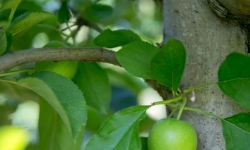How much water does Cape apple orchards use?
Previous studies on tree water use quantified the water requirements of apple orchards, but these were not exceptionally high-yielding orchards. This study focuses on a broad range of methods, drawn from the various partner organisations, to refine estimates of water use and to reduce uncertainties in the estimates of the water requirements of apple orchards.
For many years, apple orchards bearing between 60 to 80 tonnes of fruit per hectare per season (ha/season) were considered to be economically viable. But yields of up to 120 tonnes/ha/season, are now the norm. This raises alarm bells regarding the sustainability of these production practices given the increasing pressure on the availability of irrigation water in South Africa.
The first part of the study, entitled “Quantifying water use by high performing commercial apple orchards in the winter rainfall areas of South Africa” was done in two full-bearing orchards planted to the ‘Cripps’ Pink’ and ‘Golden Delicious’ cultivars; and two non-bearing orchards planted to the ‘Golden Delicious’ and ‘RosyGlo’ cultivars in the Koue Bokkeveld region of the Western Cape.
The first phase of the four-year study recently drew to a close, showing that trees with larger canopy sizes tend to use more water regardless of crop load. These preliminary results fail to show a clear relationship between crop load and transpiration. The project team measured water use on five different trees of varying stem sizes in each of the full-bearing orchards using the heat ratio method of the heat pulse velocity sap flow technique. Water use by the smaller trees was measured using Granier Probes. Additional data included the orchard microclimate, irrigation volumes, tree and orchard leaf area indices. Soil water content was measured using up to 30 soil moisture probes in the root zone of a single tree in the two ‘Golden Delicious’ orchards to ensure an accurate soil water balance assessment.
The purpose of the first phase was to determine how much more water the high-yielding orchards require, compared to lower yielding orchards measured in previous studies. The canopy size was found to be a strong factor influencing tree water use in this study. You may have a high crop load, but the leaves do most of the transpiration.
Managing the size of the transpiring leaf area is thus critical in optimising water use; therefore the project team will now follow up on this observation to gain improved insights on how high crop load influences tree water use.




